Learn tarot the easy way, I created my P.E.N.S.I method to help seekers learn tarot after decades of reading, studying and teaching tarot. As promised on our social media, I said I would blog about how to learn tarot and card meanings.
Struggling to Learn Tarot?
If you want to learn tarot, you need simple direction. Tired of trying to memorize someone else’s book? P.E.N.S.I is a simple acronym that helps you view cards in a discerning order of context layers, especially the pips which are the majority of your tarot deck. This method relies a lot less on memorizing. Instead, you learn to build associations so you don’t have to remember.
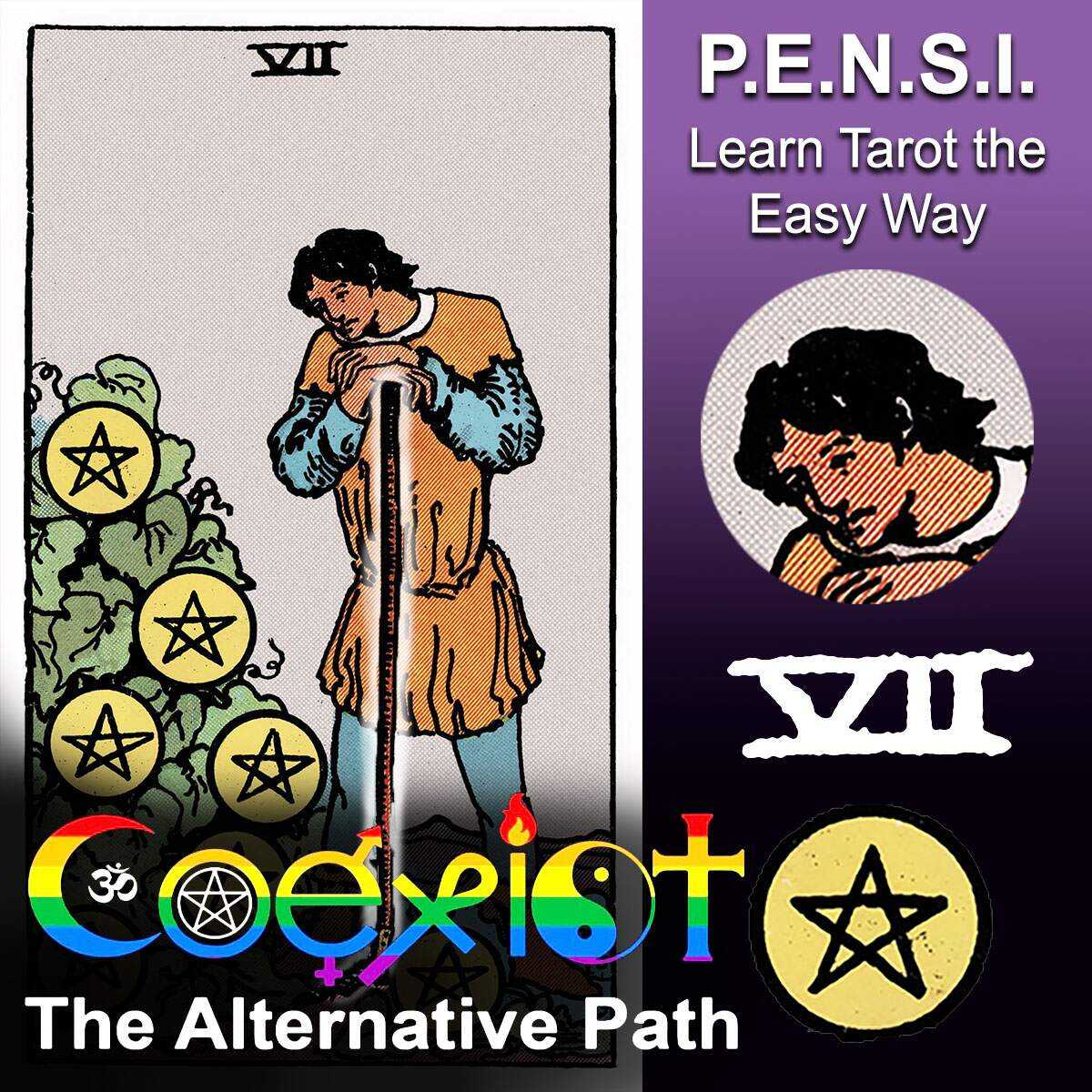 You’ll also find this method leans toward and encourages building associations with the cards vs endless memorizing. When you have strong associations, you rely less on memorizing and are more open for psychic data.
You’ll also find this method leans toward and encourages building associations with the cards vs endless memorizing. When you have strong associations, you rely less on memorizing and are more open for psychic data.
This one lesson, this first lesson will give you a huge leg-up on reading tarot! Let this one lesson sink in and you can potentially read all 40 pips in your deck. Future lessons will help refine your craft.
People that rely strictly on memorizing the keywords/phrases for 78 cards are “cold readers”, eh … not worth tipping in my opinion. I don’t teach that, try my way and you’ll shock and delight your clients.
I will be using the traditional Rider-Waite deck to illustrate future lessons, and will point out what all traditional decks have in common but address nuances too. Learn this method of reading tarot and you will be able to read any fundamental deck (pentacles/swords/wands/cups).
This first lesson applies mostly to the 40 pips, 10 each, one through ten of four different suits. But you’ll see the carry-over once we get into court cards and Major Arcana.
Learn Tarot – Don’t Miss These Free Lessons
 Sign up (it’s free and secure) to be notified of future tarot lessons and articles on witchcraft, spells and metaphysical practices.
Sign up (it’s free and secure) to be notified of future tarot lessons and articles on witchcraft, spells and metaphysical practices.
Besides, sometimes we email valuable money-saving codes and coupons for our website and brick-and-mortar metaphysical shop.
So what does P.E.N.S.I. stand for? It’s an acronym of guided prompts to help you work the metaphysical meanings of your tarot cards and provide astounding insights for your clients.
Position. The position in the spread gives the card the first layer of context. Positions mean more when viewed alongside other cards. We will get to spreads and positions later in the series. In the meantime, there’s plenty of tarot spreads on Google.
Element. Earth, Air, Fire, Water. Learn element associations for a second layer of meaning.
Numerology. Learn a basic one-to-ten system for pips. This creates a third layer of meaning.
Symbolism. Learn basic symbols and your deck’s unique ones to form a fourth layer of meaning. Notice in the image above I “called out” and enlarged specific symbols, highlighted the hoe too.
Intuition. These four layers give you layers of context and a strong base. Intuition combines them with your own psychic talents and insights about the querent and their situation.
TIP: When you are reading tarot in a spread, with each card, run it through P.E.N.S.I, and will give you tons of insight help open you up to intuitive and psychic data.
 Candles and Tarot
Candles and Tarot
Before we get started on Elements, Numerology, Symbolism and Intuition (again, we’ll circle back to Position later in the series), a quick word about candles and tarot readings.
TIP: When I read, I always have my client pick out a candle. I keep a little tray full of chime candles and watch to see what colors they touch and which they eventually select.
If you want to learn tarot well, you’ll start noticing how color choice reveals mood. emotions, even glimpses into a client’s circumstance. Sometimes, their second choice tells me even more.
Once in a while a client choses pink, and I know they were dating a lazy-ass boy-bitch wearing a man-suit and blaming a poor girl for everything. Sometimes they pick blue and it comes across they are struggling with depression, trying to protect someone from themselves, perhaps with an addiction issue, trying to protect themselves at the same time and daydreaming or longing for travel.
TIP: Placing the candle on a mirror amplifies energy, intention, and willpower. Needless to say, I go through a lot of chime candles, so I buy them in bulk.
Shipping is always free on orders $50 and over.
TIP: Study the energy of colors, any good candle magic book will teach you that. I recommend Advanced Candle Magic by Ray Buckland and The Book of Candle Magic by Madam Pamita. Study the language of the candle flame too. I watch this with card pulls and my client’s reactions and this tells me a lot too.
Now, position in a spread aside, let’s focus on E-Elements, N-Numerology, S-Symbolism and I-Intuition
Learn Tarot – The Elements
Each pip suit is numbered one through ten. To learn tarot faster, memorize this short list. This and the acronym P.E.N.S.I are about the only memorizing you need, the rest you’ll learn by association. This is a very boiled-down (numerologically speaking) set of numbers.
Some of these numbers can mean different things too, depending on what it is related to like a soul number or love number. These meanings are for ease of reading tarot, though, you can dive into full numerology if you wish.
Try to see how one number leads to the next …
1: New start, inception, a beginning, raw energy, inspiration, start of transformation. One is like a starting point, right?
2: Choice, split path, focus, polarization. Think “it takes two”.
3: Formation, Something has formed for better or ill, plan, early results. One is a point, two is a line, three is a shape, something formed.
4: Foundation, restlessness, strength with more to come. Ask for and/or accept help. Think like the foundation of a building, cool, but unfinished.
5: Sorrow, loss, regret, imbalance.
6: Calm after struggle, empathy, progress.
7: Wiser new path, practicality, necessity, creativity.
8: Struggle, halfway there, focus, personal authority, letting go, boundaries, negotiating
9: Wisdom, endurance, transformation.
10: Change, completion, fulfillment, return to 1.
Memorizing this short chain of numbers boosts your ability to learn tarot quickly and read across all four elements.
Learn Tarot Through Progression and Association
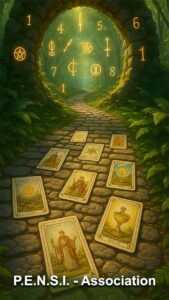 TIP: It is easier if you learn to see these numbers as a natural progression, each number leading to the next. This and the associations of the four elements are about the only memorizing needed for pips, the rest is all association.
TIP: It is easier if you learn to see these numbers as a natural progression, each number leading to the next. This and the associations of the four elements are about the only memorizing needed for pips, the rest is all association.
TIP: Memorize them yes, but try this association, notice the “1” is like a new path getting dumped on your head or bursting out of you? Here we go, look at the progression now, 2, will you choose it? If it was the Two of Cups, this could speak to a new relationship or reconciling one (cups/water rules relationships) 3 you did and something has formed; a new squeeze or reconciling with a current love interest. Make sense?
Skip to 7, 8 and 9 and link all three of those together. 7, like the 1, is a new path, but we go forward wiser, more practical, knowing better what we do or do not want., 8 would be like halfway there, and always implies struggle. It was hard to get halfway, and a way to go. 9 is like the manifestation of that path, the immediate end-result.
That makes 10 “complete”. We have been in this energy for a long minute. Sooner or later because of some idea, itch, or sudden circumstance we return to the energy of the 1.
Moving Through the Numerology
10: 1+0 =1. In numerology, numbers are often being “collapsed”, reduced to a single digit. Thus, we move forward through the numbers. Think of someone who has it all, perhaps retired but dwelling in a 10. Boredom or a new passion strike – boom! Back to a one. Remember, this is for tarot purposes, numerology is a vast science and art.
If I see where they were coming from in a five, knowing they came from a four and headed for a six. Sometimes you detect they are going backward too! Very often you find a person totally stuck in one of these, especially 4 and 5 and need to either move forward or go back and learn a lesson to be able to move forward.
 Symbolism
Symbolism
Your deck’s symbols matter. Some decks overflow with imagery; others are sparse. Study your own deck’s images, not just the guidebook.
TIP: When I choose a new deck, I eyeball the symbolism well. Is it clear, does it make sense to me? It has to be more than just the appeal of the artwork.
TIP: When you learn tarot, pull the card out while reading its description. Match each symbol to its meaning. This creates natural memory links and makes reading smoother. Either scan the card for every detail and look it up in your book, or read the book and then go look that symbol on the actual card. The greyscale images in tarot books are not as effective as looking at the actual card. The colors of symbols and images create stronger association.
Conjure the image of a young girl, in a simple white dress, barefoot in the grass. That’s a symbol. So, what words come to mind? Naive? Innocence? Youth? Pure? See, associations. Learn to make associations with the symbols. You’re taught from the time you notice, traffic lights are red, yellow and green. People don’t even have to think about it, because they are taught to associate stop, caution or go with those colors.
Do you associate green with growth or money? Of course you do. How about the expression, “are you feeling blue?” so again, make associations with symbols and colors and numbers. Then you’ll really start reading effectively for people.
 Intuition
Intuition
Intuition ties everything together. Position, element, numerology, symbolism; they’re your foundation. Practice sharpens intuition, so keep at it.
As a witch and Tarot reader, I can tell you, although you can get by with a little intuition it is worthwhile to commit to psychic development.
I recommend Psychic Witch by Mat Auryn or Llewellyn’s Little Book of Psychic Development for practical mental exercises and key meditations.
Reversed Meanings
Reversals aren’t always opposites. Sometimes they’re mirrored meanings or subtle shifts. Some are “good, better” or “bad, worse” depending on position and also the card. We’ll explore that card by card. I basically see it as one of three types.
- The Opposite; These reversed cards literally hold the opposite meaning and energy of the upright.
- The Mirror: These reversed cards are the same but different, so similar, but a couple striking differences.
- The Amplified: These reversed cards are the same thing but bigger, amplified or better, or the same thing but an even more negative or darker flavor.
For an exercise, pull out ten pips of any suit, and work through P.E.N.S.I, minus position of course.
Feel free to ask me any questions you like by leaving a comment. I answer all.
 TIP: The next lesson will kick off the Pips of Pentacles starting with the Ace of Pentacles. I’m also going to post about the Rider-Waite deck, and talk about nuances across decks. Sign up to receive notifications of newly published lessons, discounts, money-saving coupon codes and more.
TIP: The next lesson will kick off the Pips of Pentacles starting with the Ace of Pentacles. I’m also going to post about the Rider-Waite deck, and talk about nuances across decks. Sign up to receive notifications of newly published lessons, discounts, money-saving coupon codes and more.
Follow us on Instagram, Facebook (Meta) or TikTok.
Copyright © 2025 All rights reserved
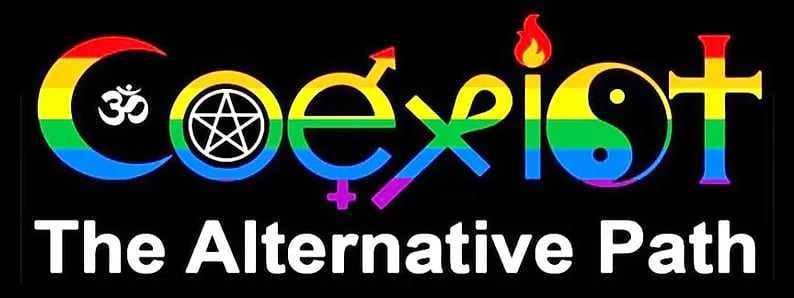
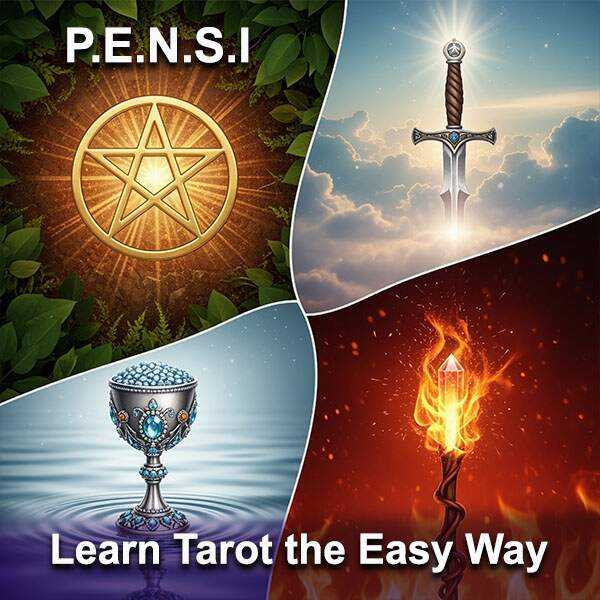
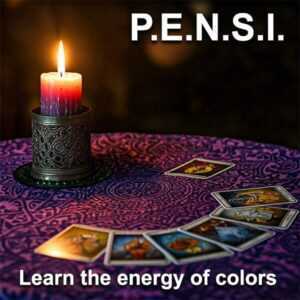 Candles and Tarot
Candles and Tarot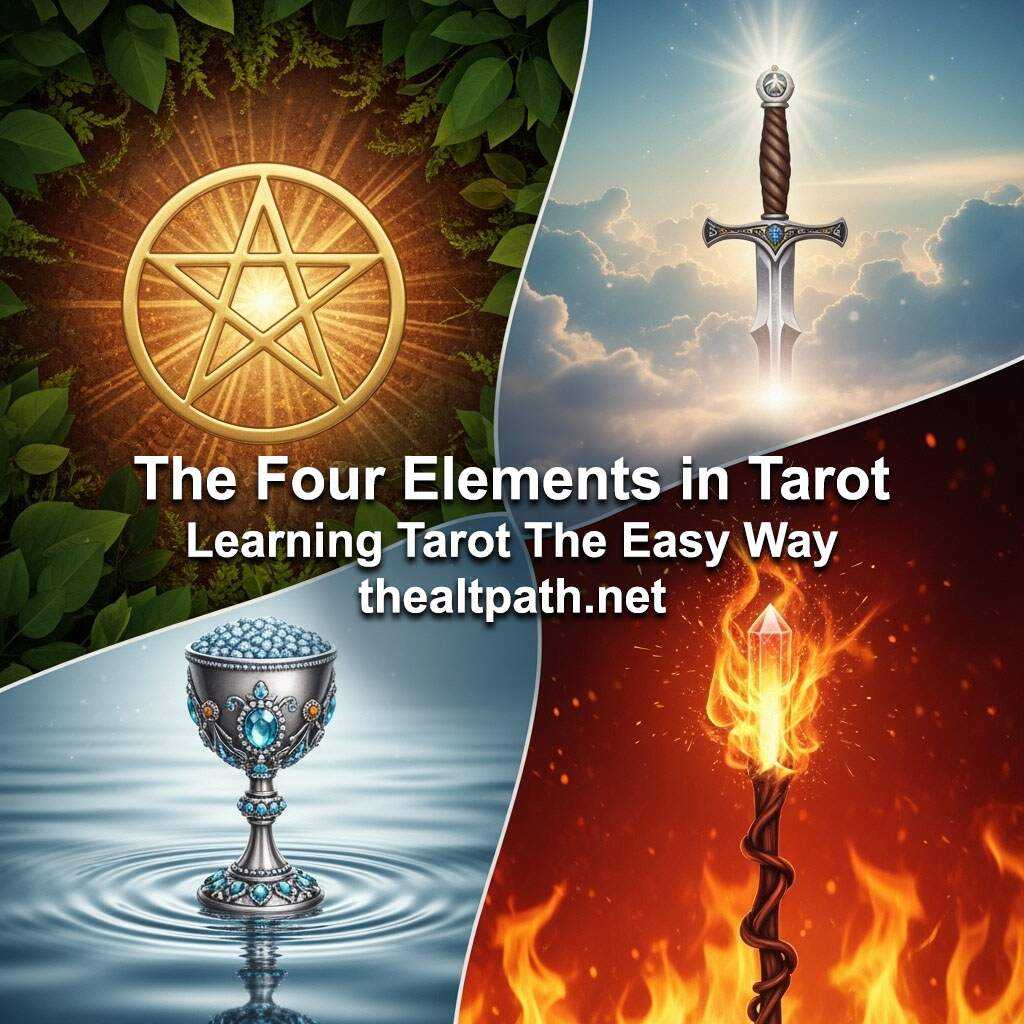
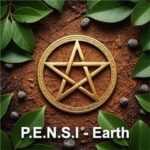 Earth: Think social life, family, and always money.
Earth: Think social life, family, and always money.  Air: Think communication, principles, and truth.
Air: Think communication, principles, and truth. 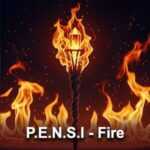 Fire: Think creativity, ambition, passions and career.
Fire: Think creativity, ambition, passions and career.  Water: Think relationships of all kinds, psychic talents and emotions.
Water: Think relationships of all kinds, psychic talents and emotions. 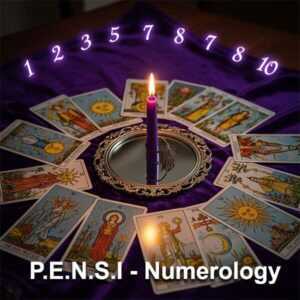 Numerology
Numerology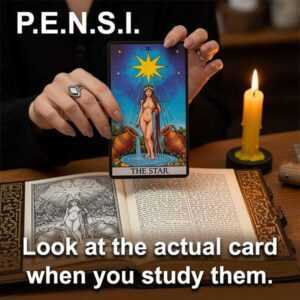 Symbolism
Symbolism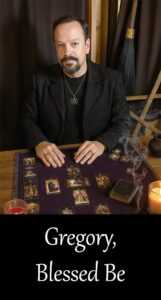 Intuition
Intuition



You taught me tarot and I must say it has truly helped me understand and be a better reader. This is much easier than reading long chapters of books for me. I must say this is very helpful for those who are asking to learn.
🙂 Hello dear Megan … thank you. I loved spending that time with you and you learned well! Yes, endless memorizing …. it sucks, you are right in the middle of a reading and you draw a blank. I see that happen to inexperienced readers relying on keywords and phrases … association is the way to go! True, my method takes a little memorizing, like the four elements’ simplicity in their respective “wheelhouses” and the one through ten numbers with a tad of numerology … But the rest is all associations that are easy to make compared to endless memorizing and a lot more natural too. I’m glad you tried my way years ago. Look at you read now! I hear good things from clients that get readings from you, and loving it. Well done Megan … well done. Blessings!
I have been studying PENSI. I feel like it is a fantastic system. Very lucky to have found this system.
Thank you Luna, 🙂 I am glad it is useful for you. I just wish I could pump all the other posts that go with it out quicker, lol. But at the same time, I enjoy writing about tarot.
Hey, dont knock it till you try it! Different tools can enhance intuition. 😉
P.E.N.S.I. Has been helpful to me as a newer witch. It helped me learn/clarify so many things at once. Thank you!
🙂 Hello Erika, I’m glad you find my method useful. I find that this method also prompts more than a tarot book alone when it comes to intuition and psychic data.
I dont buy into all this Tarot really … I think it’s just bularky and manipulation. Id rather stick with logic and reason than rely on some mystical cards
Tarot is a tool for introspection and reflection. Keep an open mind, you might be surprised.